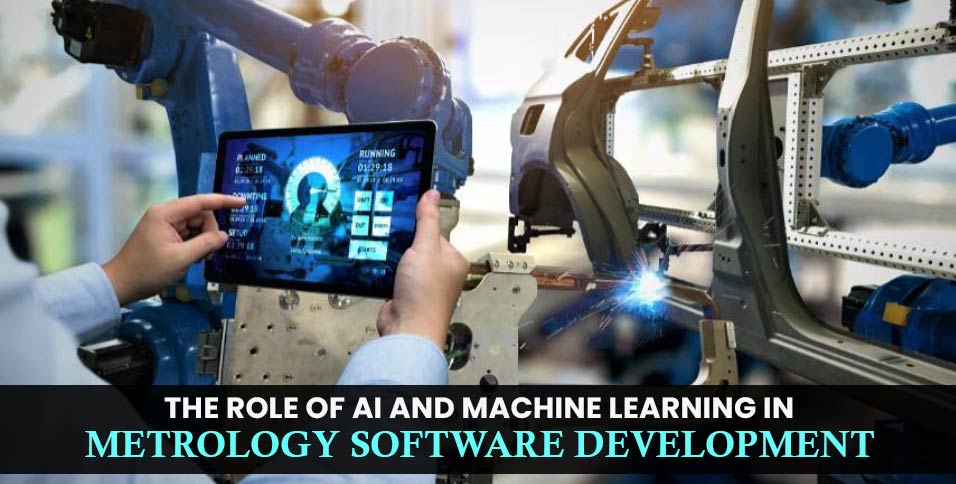Over the years, the rapid growth of artificial intelligence (AI) and machine learning (ML) has transformed various industries, including metrology. The development of metrology software has seen progress thanks to AI and ML algorithms, resulting in enhanced precision, efficiency, and cost-effectiveness. This article explores how AI and ML have influenced the evolution of metrology software, emphasising their advantages and their impact on the industry.
Getting to Know Metrology Software Development
Before delving into the effects of AI and ML on metrology software products and their development, it’s essential to grasp the field. Metrology involves measurement techniques across physical quantities. In sectors like automotive, aerospace, and consumer electronics, among others, metrology plays a significant role in ensuring product quality through measurements.
Metrology software aids in diverse measurement tasks such as analysis, geometric assessment, surface roughness evaluation and statistical process control. These software solutions are crafted to streamline measurement procedures by leveraging technologies like AI and ML.
Improving Measurement Precision with AI
An advantage brought by AI in metrology software advancement is heightened accuracy. Conventional measurement approaches are susceptible to errors stemming from data gathering and analysis. However, utilizing AI-driven solutions, such as those offered by Endertech, allows for the automation of measurements with unparalleled accuracy.
However, utilising AI-driven solutions allows for the automation of measurements with accuracy.
AI algorithms can be trained on datasets collected during production processes or from data. By employing machine learning techniques like regression models or neural networks to analyse these datasets comprehensively, the software can detect patterns that precisely determine measured values without the need for involvement.
Moreover, apart from reducing the potential for error in measuring dimensions or assessing features through visual comparisons or mathematical formulas accurately, AI algorithms also minimise subjective measurements that typically require experts to use visualisation tools for detailed analysis.
Enhancing Efficiency Through Machine Learning
Machine learning algorithms have transformed the development of metrology software by enhancing efficiency. Traditional manual measurement methods often involve time-consuming processes, especially when dealing with geometries. With ML algorithms, measurements can now be carried out swiftly within shorter time frames.
By leveraging techniques such as clustering or classification, ML algorithms automate the identification of landmarks on 3D models or digitised images. This capability greatly accelerates tasks that previously relied on input. Additionally, advanced algorithms excel in detecting outliers, ensuring covariance estimations within datasets.
Driving Cost Effectiveness
The adoption of AI and ML technologies is also contributing to cost-effectiveness in the metrology sector. In the past, inspection procedures were resource-intensive and demanded skilled personnel to operate specialised equipment. With the use of AI-driven software solutions, staff members can now carry out inspections without compromising accuracy.
Furthermore, by automating measurement tasks and minimising errors, industries have seen a decrease in scrap rates, leading to the elimination of product rejection due to quality standards issues. Manufacturers no longer have to depend on rework efforts and can maintain consistency in production processes while cutting down on expenses.
Evolving Instruments – Smart Operational Control
Advancements in technology have brought about operational control systems that combine AI and metrology software development. These systems are equipped with machine-learning capabilities that enable the adjustment of operation settings. These intelligent instruments can adjust parameters dynamically based on performance feedback from machine learning algorithms.
For instance, applications like semiconductor lithography machines utilise equipment with sensors and self-learning software designed for image recognition challenges or robot arm control. Real-time adjustments in measurements help to address deviations during production processes, reduce defects, optimise robot automation corrections and ensure operation transitions between sequences.
Conclusion
Any industry that relies on measurement techniques stands to gain advantages from incorporating AI and machine learning algorithms into their metrology software tools.
Enhanced precision and improved efficiency through turnaround times achieved by an automated process depend on prior advancements. Evolution persists without relying on humans, ultimately leading to production standards, decreased expenses and complete sustainable growth with unlimited potential for improvement sans human constraints.
As artificial intelligence (AI) and machine learning (ML) progress rapidly, the significance of these technologies in the development of metrology software is expected to expand. By embracing these advancements, industries can access levels of precision, efficiency and cost-effectiveness that were previously out of reach. With experts pushing the boundaries of what’s achievable, the future of metrology holds promising opportunities for industries worldwide.














